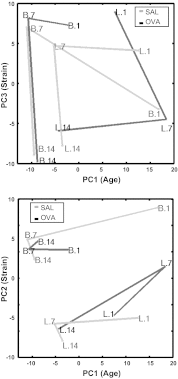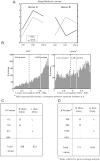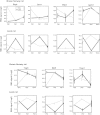Maternal allergen exposure reprograms the developmental lung transcriptome in atopic and normoresponsive rat pups
- PMID: 22983352
- PMCID: PMC3517678
- DOI: 10.1152/ajplung.00179.2012
Maternal allergen exposure reprograms the developmental lung transcriptome in atopic and normoresponsive rat pups
Abstract
The "fetal origins hypothesis" argued that physiological changes consequent to in utero exposures ultimately contribute to disease susceptibility in later life. The dramatic increase in asthma prevalence is attributed to early exposures acting on preexisting asthma-susceptible genotypes. We showed previously that distinct transcriptome signatures distinguish the developmental respiratory phenotype of atopic (Brown Norway, BN) and normoresponsive (Lewis) rats. We aimed to determine whether maternal allergen exposure would influence asthma pathogenesis by reprogramming primary patterns of developmental lung gene expression. Postnatal offspring of dams sensitized to ovalbumin before mating and challenged during pregnancy were assessed for lung function, inflammatory biomarkers, and respiratory gene expression. Although maternal ovalbumin exposure resulted in characteristic features of an allergic response (bronchoalveolar lavage neutrophils, IgE, methacholine-induced lung resistance) in offspring of both strains, substantial strain-specific differences were observed in respiratory gene expression. Of 799 probes representing the top 5% of transcriptomic variation, only 112 (14%) were affected in both strains. Strain-specific gene signatures also exhibited marked differences in enrichment for gene ontologies, with immune regulation and cell proliferation being prominent in the BN strain, cell cycle and microtubule assembly gene sets in the Lewis strain. Multiple ovalbumin-specific probes in both strains were also differentially expressed in lymphoblastoid cell lines from human asthmatic vs. nonasthmatic sibling pairs. Our data point to the existence of distinct, genetically programmed responses to maternal exposures in developing lung. These different response patterns, if recapitulated in human fetal development, can contribute to long-term pulmonary health including interindividual susceptibility to asthma.
Figures









Similar articles
-
Maternal asthma is associated with persistent changes in allergic offspring antibody glycosylation.Clin Exp Allergy. 2020 Apr;50(4):520-531. doi: 10.1111/cea.13559. Epub 2020 Jan 28. Clin Exp Allergy. 2020. PMID: 31912551
-
Maternal house dust mite exposure during pregnancy enhances severity of house dust mite-induced asthma in murine offspring.J Allergy Clin Immunol. 2017 Nov;140(5):1404-1415.e9. doi: 10.1016/j.jaci.2016.12.972. Epub 2017 Feb 9. J Allergy Clin Immunol. 2017. PMID: 28192144 Free PMC article.
-
Chronic, Elevated Maternal Corticosterone During Pregnancy in the Mouse Increases Allergic Airway Inflammation in Offspring.Front Immunol. 2020 Jan 21;10:3134. doi: 10.3389/fimmu.2019.03134. eCollection 2019. Front Immunol. 2020. PMID: 32038643 Free PMC article.
-
Maternal allergen exposure as a risk factor for childhood asthma.Curr Allergy Asthma Rep. 2006 Feb;6(1):75-80. doi: 10.1007/s11882-006-0014-7. Curr Allergy Asthma Rep. 2006. PMID: 16476199 Review.
-
Prenatal environmental factors influencing IgE levels, atopy and early asthma.Curr Opin Allergy Clin Immunol. 2013 Apr;13(2):187-92. doi: 10.1097/ACI.0b013e32835e82d3. Curr Opin Allergy Clin Immunol. 2013. PMID: 23385288 Review.
Cited by
-
Derangement of cell cycle markers in peripheral blood mononuclear cells of asthmatic patients as a reliable biomarker for asthma control.Sci Rep. 2021 Jun 4;11(1):11873. doi: 10.1038/s41598-021-91087-5. Sci Rep. 2021. PMID: 34088958 Free PMC article.
-
Preclinical models of maternal asthma and progeny outcomes: a scoping review.Eur Respir Rev. 2024 Feb 28;33(171):230174. doi: 10.1183/16000617.0174-2023. Print 2024 Jan 31. Eur Respir Rev. 2024. PMID: 38417970 Free PMC article.
-
The lipid peroxidation product 4-hydroxynonenal inhibits NLRP3 inflammasome activation and macrophage pyroptosis.Cell Death Differ. 2022 Sep;29(9):1790-1803. doi: 10.1038/s41418-022-00966-5. Epub 2022 Mar 9. Cell Death Differ. 2022. PMID: 35264781 Free PMC article.
-
The transcriptomic signature of respiratory sensitizers using an alveolar model.Cell Biol Toxicol. 2024 Apr 8;40(1):21. doi: 10.1007/s10565-024-09860-x. Cell Biol Toxicol. 2024. PMID: 38584208 Free PMC article.
References
-
- Baraldi E, Filippone M. Chronic lung disease after premature birth. N Engl J Med 357: 1946– 1955, 2007 - PubMed
-
- Barker D. Fetal and Neonatal Origins of Adult Disease. London: BMJ, 1992
-
- Bellofiore S, Martin JG. Antigen challenge of sensitized rats increases airway responsiveness to methacholine. J Appl Physiol 65: 1642– 1646, 1988 - PubMed
Publication types
MeSH terms
Substances
Grants and funding
LinkOut - more resources
Full Text Sources
Medical
Molecular Biology Databases

